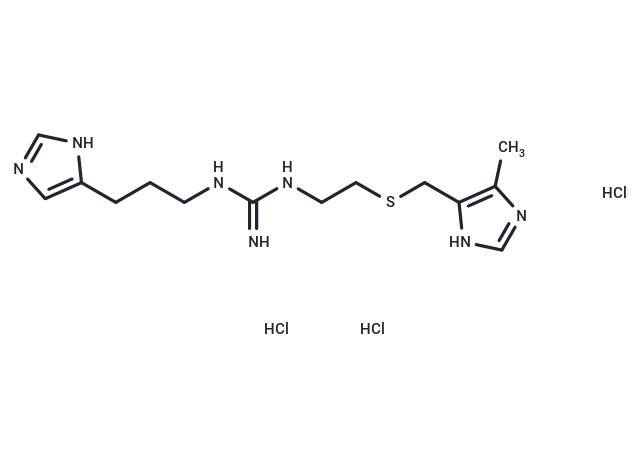Shopping Cart
Remove All Your shopping cart is currently empty
Your shopping cart is currently empty
Impromidine hydrochloride is a very potent and specific histamine H2 receptor agonist for conducting cardiovascular studies.

| Pack Size | Price | USA Warehouse | Global Warehouse | Quantity |
|---|---|---|---|---|
| 1 mg | $155 | - | In Stock | |
| 5 mg | $385 | - | In Stock | |
| 10 mg | $548 | - | In Stock | |
| 25 mg | $822 | - | In Stock |
| Description | Impromidine hydrochloride is a very potent and specific histamine H2 receptor agonist for conducting cardiovascular studies. |
| In vitro | Impromidine hydrochloride (1 X 10(-4) M; human isolated left ventricular) inhibited maximal responses to histamine to a level equal to the maximal Impromidine hydrochloride response; however, Impromidine hydrochloride did not inhibit responses to isoprenaline. Positive inotropic activity and inhibition of maximal responses to histamine occurred over a similar Impromidine hydrochloride concentration range. Impromidine hydrochloride displaced histamine concentration-response curves to the right, whereas mepyramine had no effect on responses to histamine. It is concluded that Impromidine hydrochloride has positive inotropic activity on the human ventricle, that the response is mediated via histamine H2-receptors, and that Impromidine hydrochloride is a partial agonist compared with histamine.[2] |
| In vivo | Impromidine hydrochloride (0.46 to 46 nmol/kg/h; dog; 45-min steps) produced the same maximum stimulation of gastric HCI output, increase of HR, and fall in systolic blood pressure as histamine. Impromidine hydrochloride was 38 times more potent than histamine in the stimulation of acid (ED50 3.8 nmol/kg/h) and 30 times more potent in raising HR (ED50 5.6 vs. 172 nmol/kg.hr). The effects of Impromidine hydrochloride on pepsin secretion were qualitatively and quantitatively similar to those of histamine and other H-2 agonists with weak stimulation at low doses and progressive inhibition with increasing doses of Impromidine hydrochloride. Coupling the results with the known high specificity of Impromidine hydrochloride, gastric acid secretion, chronotropic, and hypotension all seem to be purely H-2-mediated effects of histamine in the intact conscious dog.[1] |
| Molecular Weight | 430.83 |
| Formula | C14H26Cl3N7S |
| Cas No. | 65573-02-6 |
| Smiles | N=C(NCCCC1=CN=CN1)NCCSCC2=C(C)N=CN2.Cl.Cl.Cl |
| Color | Yellow |
| Appearance | Oil |
| Storage | store under nitrogen | Pure form: -20°C for 3 years | In solvent: -80°C for 1 year | Shipping with blue ice/Shipping at ambient temperature. | ||||||||||||||||||||||||||||||
| Solubility Information | DMSO: 27.5 mg/mL (63.83 mM), Sonication is recommended. | ||||||||||||||||||||||||||||||
Solution Preparation Table | |||||||||||||||||||||||||||||||
DMSO
| |||||||||||||||||||||||||||||||
| Size | Quantity | Unit Price | Amount | Operation |
|---|

Copyright © 2015-2025 TargetMol Chemicals Inc. All Rights Reserved.